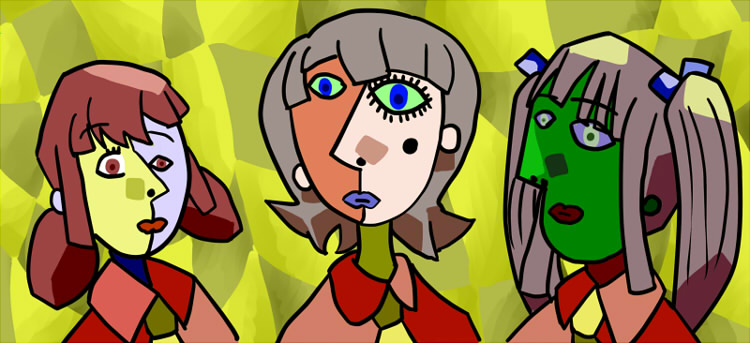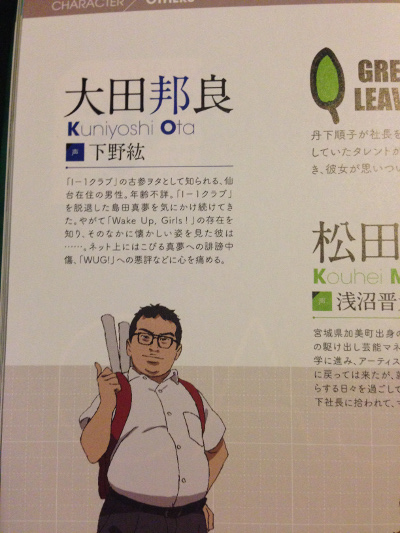Final Notes on Wake Up, Girls!

Wake Up, Girls wrapped up on Friday. I have to admit, going into the last anime season, it was the new show I was looking forward to the most, even if the reasons for that weren’t exactly the purest (or, rather, there was a certain amount of expected Yamakan-related schadenfreude going into it).
As the show progressed, it was probably the new series (as in, not Kill la Kill or Build Fighters or any carryover from the prior season) that I followed most closely week to week, though, ultimately, it ended up being a bit of a weird kettle of fish.
When the show first started, coming out from that movie and the first TV episode, my comments regarding it was that the shows overriding flavour was one of cynicism, or perhaps condescension – it’s a show which put it’s foot forward in a fashion that, whilst clearly trying to promote it’s real-life idols and associated paraphernalia, was also really down on the audience that it was trying to sell them to. This rather peaked in the shows second TV episode, where the girls are made to perform at a resort whilst wearing skimpy swimsuits – it’s fanservice, or what the audience watching such shows would normally mentally flag as such, but done in such a staggeringly uncomfortable fashion that it’s hard to find it particularly titillating.
That particular brand of cynicism, outside of perhaps somethings which could broadly be considered commentary on the fickle nature of the idol fandom, rather mellows out shortly after the events of the second episode, though. It’s replaced by idol meat-farm antics of the president of I-1 Club, as he mercilessly cuts members and understudies, by number rather than name, alike whilst chanting the mantra “Don’t Rest! Don’t Complain! Don’t Think!”.
It’s this kind of thing that has 3D, real-world idol fans a smidgen annoyed at the show, in so much as it comes across as a somewhat superficial reading of the industry from someone who is mostly interested in being a critic of it, without necessarily being fully aware of the circumstances. This isn’t to say that I don’t think that idol fans aren’t sometimes somewhat naive about the industries realities, and it often takes something as gross as the whole head shaving incident to really see that, but what WUG chooses to represent is clearly an exaggeration of what isn’t even necessarily the worst aspect of the industry. It’s merely done to be a stark contrast to the homely grass-routes idol approach Green Leaves is following.
The real problem with I-1, though, is that we simply don’t spend enough time with them to particularly give a damn about the sword of Damocles hanging over them. We see members getting dropped left and right, but none of them are named, only numbered, except for the one which was way in the past. There’s only the one current member we spend any real amount of time with, and she’s there mostly just to serve as a foil to Mayu. I’d maybe argue that it’s supposed to be some kind of commentary – that, given the sheer number of girls in these outfits, it’s surely hard to give that many damns about about any particular member – but then I remember that they are actually merchandising that handful of I-1 Club members that do do actually name.
Also, it’s not like characterisation was particularly WUGs strongpoint anyway. Whilst I’d like to think it’s because of her chipper attitude, it’s probably a little telling that the most popular character (or, at least, the only one most people can actually name) was Minami, who has the greatest concentration of anime-moe charm-points, with the adorable gluttony and cat-like poses. Miyu gets away to a certain degree just by being otaku, but many of the others just blend into an indistinct blob for anyone without some kind of external interest. That many characters have their whole plot-arc amount to about two scenes doesn’t really help make them feel like anything other than stage-filler either.

You aren’t fooling anyone by oh-so-subtly calling your nerd OTA KUniyoshi, Yamakan
There’s also some really peculiar messaging. That we see our girls signing songs about the Lovecraftian Elder Gods is a bit too on the nose, even with the
The big stick-in-the-mud regarding the show, that has gone unmentioned up until this point, is the shows animation. WUG…isn’t a particularly great looking show. It’s full of wonky, off-model artwork, and more than a few straight-up animation errors. Whilst I think the (in comparison to other idol show) more earthy, naturalistic colour palette used in the show was absolutely the right choice given the general tone of the material, it’s also really demanding on the artists. The bright, poster-paint like colour-scheme of the likes of Love Live or Aikatsu can hide a multitude of sins and simplified character and background art, whilst still looking attractive. In WUG, not so much.
Looking from the outside-in, it’s a little difficult to fathom out what exactly happened here – whether it’s purely scheduling issues, or simply that they actually were working with inexperienced animators solicited via Twitter. It’s not as if Tatsunoko’s other big recent production, Gatchaman Crowds, had consistently great animation either – a couple of the broadcast episodes, at least, looked a little wonky – but that had an idiosyncratic enough look to it that it could get away with it.
I’d like to say Yamakan makes the best of a bad situation – part of directing anime is to know the ability of your animators, and to storyboard and allocate cuts appropriately – but that’s probably giving a little too much credit. The unfortunate reality of idol shows is that they are enormously taxing on your animation staff, particularly when it comes to dance scenes – it’s why Love Live and Aikatsu make such heavy use of CG. The fact that the emotional climax of the series in the final episode, the big stage performance, cuts away to two almost static talking heads for a good portion of it displays something of a defeatist attitude in that regard. It’s compromising direction in the least inventive manner possible.
On a more positive note, the show does largely nail the music. It’s not really that much of a surprise, given that the fine folks at Monaca aren’t exactly strangers to cartoon idol music. WUGs music swings a little – just a little – more towards “proper” idol music than the more anisong-esque efforts of Aikatsu or iM@S, but it’s somewhat more interesting for it. I do think the intro of 7 Girls War is rather on the goofy side, but it’s an otherwise catchy number. The main theme of the movie, Tachiagare!, was pretty much the last single release baring the name of anisong-legend Satoru Kousaki before he started his current health-related hiatus.

Yeah, I have WUG stuff
All being said, I’m probably doing my usual thing and coming across far more negatively about the show than I actually intended to be – for all that it’s animation problems ended up severally compromising the rest of the production, I did genuinely enjoy what WUG had to offer. Whilst it may dial back on it’s cynicism by the time you get to the end of the show, it still had a distinct flavour to it that differentiates it from Love Live or iM@S or Aikatsu. Even if it doesn’t necessarily deliver on the malicious promise of it’s first couple of episodes, it goes continue to do, if not necessarily always interesting, then certainly peculiar things as it goes along. I’m not really sure that I’d recommend it to someone who isn’t already drinking the 2.5D-idol cool-aid, but it’s certainly worth a gander for those who are.

2014-03-31
#
There were some really janky scenes in WUG, but overall it was okay. I think the taste of poor animation far overstates the actual quality of the stuff. Just like Yamakan’s reputation versus his work product. Even episode 12 was largely passable with just a couple really rough spots.
I think actually WUG is the kind of anime that is best for a more mainstream-tasting anime audience. It is much more liken live action material than the fancy multicolored worlds that describes the likes of Aikatsu or Love Live. I’d say this is probably much more preferable to most idol anime out there, for pre-cool-aid types.
2014-03-31
#
I was inclined to agree with you at first blush – outside a couple of real clunkers like the magic extra arm in the pre-concert scene in the movie, it didn’t look that bad most of the time, but when I was going back in to check a couple of things earlier today, pretty much every cut I checked (in mid-series episodes) looked immediately off-model.
I really don’t mean to sound so negative about the show, though, but I pretty much find myself unable to write about anything in a positive fashion…
This is probably true, though in making the closing statement, I’m somewhat making assumptions about the kind of person who actually reads this blog on occasion – people who watch anime, but are not necessarily into cartoon idol culture. For those folks, I think something like aniM@S or Love Live (or Aikatsu, if they’re the Precure sort) might actually have more milage. For those who aren’t neck-deep into cartoons, yeah, the less hyper-cartoon approach of WUG is probably far more palatable.
2014-04-01
#
Omo assisted me a bit during my (supposed) WUG pilgrimage in which I just visited a mere 3 or 5 of them in Sendai. I discovered that this anime pilgrimage thing is either not for me, or maybe it’s the fault of the content itself.
At first I saw WUG as a meta-anime which references not only other popular anime/idol anime tropes but those of the 3D idol genre itself. Having seen Amachan (also set in Tohoku region), some knowledge of AKB48 and other million-idol groups, the nods to those in WUG excited me. After a few episodes either the references die down or are too specific for my shallow idol knowledge, and then my entertainment willowed down to it being just a slice-of-life.
Characterization is important to me though when it comes to slice-of-life, and in this case I feel that a movie and a cour wasn’t enough to flesh the WUG out, much less the I-1 girls. I would agree that Minami gets the best recall, mostly because her umee-nyan gestures mirror how Nico Nico Nii would be memorable in Love Live. In terms of story, see how IM@S and Love Live didn’t have much story progression but WUG has it quick in comparison. Maybe the balance of story and characterization isn’t as effective here.
2014-04-01
#
“or Aikatsu, if they’re the Precure sort”
Does this mean I need to watch Precure?
2014-04-03
#
Everyone needs to watch Precure.